Sorry, I didn’t think the “Danger Will Robinson” gif would be an obscure reference.
I am thinking that anytime you bypass the BMS, especially for high amp charging, it creates a dangerous scenario. In this case, dangerous to your cells, unless you became the BMS and constantly monitor cell voltages and overall battery charging amps. It’s possible, I was a BMS for many months but it’s easy to destroy cells as it gets out of hand in just a couple minutes. Implementing this as a final solution, in my mind anyway, will eventually end in calamity.
There is no free lunch in alternator charging. Good solutions are expensive because the handle a lot of amps and protect your other expensive equipment intelligently and reliably. Like an SCC, money spent on a quality DC-DC charger is a good investment.
If there was another cheaper and easier shortcut, I am sure we would have heard about it.





